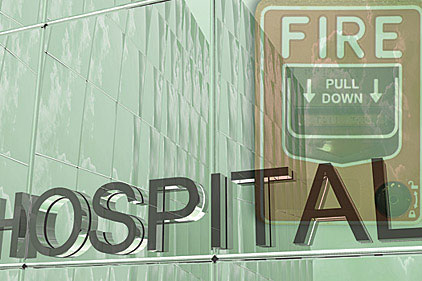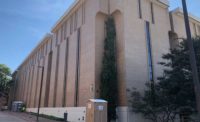Today’s hospitals and specialized care facilities integrate a slew of building technologies to ensure all systems function as intended to provide state-of-the-art care for patients. Many of these hospital building systems rely on interdependency on other components for their proper operation and function. Everyone is aware of how critical mechanical, electrical, and plumbing systems are to a hospital’s daily operations — appropriate HVAC design to help control infections and keep temperatures at comfortable levels, or proper electrical design to provide uninterrupted power for life support equipment, for instance. But just as importantly, fire protection and life safety systems are vital to the everyday operations of a hospital.
The building fire alarm system, fire suppression systems, and passive fire-rated construction all ensure building safety for its occupants in the event of a fire emergency — especially compared with most other types of buildings given a hospital’s unique “Defend in Place” strategy, which requires patients to shelter in place rather than the evacuation procedures you might see in other typical buildings.
This article will focus on the important fire protection and life safety parameters and concepts that must be carefully evaluated during the design phase of a hospital renovation and/or addition. But keep in mind, each section below requires much further in-depth coordination, analysis, and integration than what is covered here to fully implement the level of protection that fire codes intend for hospital facilities.
Before getting into individual coordination requirements for a planned hospital renovation, any design team must identify the specific governing codes and standards that are applicable to the project. The design team needs to ask:
- What are the applicable building and NFPA codes for the project?
- Are there any local jurisdictional amendments to the adopted model building and fire codes?
- Are there any governing agency requirements that apply to this case? Some examples of those include Veterans Affairs (VA) Design Manual and Unified Facilities Criteria (UFC) for NAVFAC hospitals.
- Do Joint Commission/Centers for Medicare & Medicaid Services (CMS) regulations apply to the hospital?
- Is there a State Healthcare Governing Board to whom the project needs to be submitted for review?
If any of the above code applicability scenarios apply to the project, the design team will need to closely work with the project code consultant and Authority Having Jurisdiction (AHJ) to ensure the design and subsequent construction meets all requirements to ensure patient and staff safety.
Fire Alarm Systems
The complex design of today’s fire alarm systems requires coordination with more than just fire suppression systems (i.e., automatic sprinkler systems). With the continuous evolution and expansion of assimilated and multifaceted hospital building systems, an added layer of coordination with existing building fire alarm system(s) is required to ensure various hospital building components are monitored properly and the appropriate level of functions occur upon fire alarm activation. The following are a sample of fire alarm design parameters that are critical to evaluate prior to renovating an existing health care facility.
Notification and detection device selection. Selection of a fire alarm device is an important, and frequently overlooked, component in the fire alarm design process. Too often, standard fire alarm horns or speakers are specified throughout a health care facility, regardless of a room’s type or use. So for suites or compartments where patients sleep, designers should consider the use of audible chimes instead of more jarring horns. In addition, designers should incorporate textual emergency signs in operating rooms to eliminate the need for bright strobes or loud horns and speakers that would otherwise interrupt a delicate operation underway.
When it comes to the selection of detection devices, designers should carefully specify smoke detectors when absolutely required by code. A hospital’s governing fire codes allow for smoke detection to be utilized as a substitute for other prescriptive requirements (i.e., smoke detectors in rooms open to a corridor and inside individual patient rooms that are not in the line of sight of a nurse’s station). When unnecessary smoke detectors are introduced into a project, they place an ongoing maintenance and testing burden on a hospital’s facilities staff. While fire codes call for a mandatory number of smoke detection devices, designers should keep such detectors to a minimum as much as possible.
Lastly, the designer should make certain that the hospital’s existing fire alarm system has the spare circuits and capacity to connect to additional fire alarm zones in an addition. If that level of capacity is unavailable or unknown, the designer should consider providing a new, standalone subpanel to serve the expanded or renovated area. It is important to specify that the new subpanel be fully compatible, and can communicate, with the hospital’s existing fire alarm control panel.
Smoke compartments. Coordinate any new proposed smoke compartments to ensure that the fire alarm zones correlate with existing smoke compartment boundaries. Aligning fire alarm zones to smoke compartment boundaries will both ensure the fire alarm circuits are contained within their specified area and allow for easier identification during construction. In addition, maintaining fire alarm circuits to specific smoke compartments will aid local fire departments in cases where they must broadcast individual messages by compartment.
Emergency power generators. All existing and newly proposed emergency standby generators providing power to any life safety systems (fire pump, exit signs, elevators, atrium smoke control, etc.) need to be monitored by the building fire alarm system. That monitoring status includes generator operations and fault conditions. Many times during a hospital expansion, a new standby emergency generator is provided to serve the addition. Normally, the existing hospital’s generators were monitored from the point when they were originally installed. But problems sometimes emerge during expansion projects if designers do not incorporate a newly installed generator in the process.
Security/access control. If any new or renovated areas entail infant care, labor and delivery, and/or psychiatric care, designers need to ensure that any required access control/security doors are connected and integrated with the facility fire alarm system, noting that not all doors are required to be available for egress out of these high-security concern areas. For such sensitive areas of a hospital, it is important to ensure the doors that are part of the means of egress out of the space “fail open” in the event of a fire emergency. This is accomplished by integrating addressable fire alarm relay modules to the access control doors for automatic release upon a fire alarm’s activation.
HVAC. One of the most frequently overlooked and under-coordinated building systems, when it comes to fire alarm system integration for a hospital renovation or addition, is the connection and operation of fire and/or smoke dampers in HVAC ducted systems. Most building operators and designers are aware that fire and/or combination smoke dampers are required at penetrations of ducts through fire or smoke barrier partitions. The issue comes into play when full coordination fails to occur between the project architect, fire alarm designer, and electrical and mechanical engineers. It is very important for these disciplines to fully comprehend all of the anticipated fire and smoke rated partitions as part of a hospital’s renovation or addition. The following provides the typical design guidelines to follow to ensure full coordination and monitoring of fire and smoke dampers by the building’s fire alarm system.
The project architect, along with the project life safety consultant (if available), should continuously identify all areas within the expansion and/or addition scope that will require fire-rated or smoke-protected construction. In a hospital, there are numerous code requirements for inclusion of fire rated and smoke barriers to compartment various hospital building sections to ensure the “defend in place” strategy is achieved. A few examples of the typical fire and smoke ratings required in hospitals are as follows:
- Vertical openings serving four or more stories – 2-hr fire barriers
- Vertical openings serving three stories and less - 1-hr fire barriers
- Walls and partitions forming smoke compartment boundaries - 1-hr fire/smoke barrier
- Walls and partitions separating ambulatory care, assembly areas, or business occupancy areas from hospital patient and treatment areas - 2-hr fire barriers
- Boiler and fuel-fired heater rooms - 1-hr fire barriers
- Central/bulk laundry rooms larger than 100 sq ft (9.3 m2) - 1-hr fire barriers
- Laboratories that would be classified as severe hazard in accordance with NFPA 99, Standard for Health Care Facilities - 1-hr fire barriers
- Typical paint shops - 1-hr fire barriers
- Physical plant maintenance shops - 1-hr fire barriers
- Rooms with soiled linen in volume exceeding 64 gal (242 L)
- 1-hr fire barriers
- Trash rooms with collected trash in volume exceeding 64 gal (242 L) - 1-hr fire barriers
The next step is for the mechanical engineer to provide the appropriate type of damper (fire, smoke, or combination fire/smoke) for duct penetrations of the various wall assemblies listed above. Once all damper locations have been identified, the project’s fire alarm or electrical designer should identify all locations of smoke dampers on the fire alarm or electrical drawings.
Codes require all ductwork passing through smoke barrier walls to be provided with smoke dampers and associated smoke detection devices (spot or duct type). Ductwork passing through 2-hr fire smoke barriers are to be provided with combination fire/smoke dampers and associated detection. Upon operation, the detection device will typically indicate “supervisory” alarm status at the building fire alarm control panel and will simultaneously initiate smoke damper closure and corresponding AHU shutdown. Ductwork passing through fire barriers will simply be provided with passive fire dampers. There are two options for smoke detector/smoke damper specifications that are critical for proper coordination. Let’s review them.
- The project’s mechanical engineer indicates and specifies both the detection device and smoke damper to ensure compatibility between the two components. In this instance, the mechanical design is assuming responsibility for the entire smoke damper component. Therefore, it is critical that the mechanical specifications instruct the installation contractor to provide smoke detectors that are fully compatible with the base building fire alarm system. With this option, the mechanical contractor will be responsible for the purchase of the smoke damper and associated detection device, as well as the installation of both components. The smoke detector (spot type or duct type) associated with smoke damper operation needs to be monitored by the existing hospital fire alarm system and therefore should be indicated on the fire alarm or electrical drawings for connection only.
- The other option is for the mechanical engineer to only indicate the smoke damper on the mechanical drawings and the fire alarm designer to indicate the associated detection device on the fire alarm or electrical drawings to ensure that compatibility with the base building fire alarm system is achieved. Under this option, the associated smoke damper detector would be indicated on the fire alarm or electrical drawings for both the purchase and installation by the fire alarm or electrical contractor.
Automatic Sprinkler Design
The design of the automatic suppression in hospitals is not as complex when compared with other systems; however, specific design aspects have to be addressed to make sure this critical life safety system is designed for optimal performance in a hospital setting. The following summarizes several fire suppression design considerations for hospital renovation projects.
- Any new sprinkler zones shall match and be limited to the smoke compartment in which they are located. It is not a code requirement for the sprinkler zone to match the smoke compartment boundary; however, it is a good design feature to provide a less complex, well-defined and coordinated system. If future renovations are required to the sprinkler system, the partial shutdown of the automatic sprinkler system will be limited to only one specific smoke compartment. In addition, eliminating unnecessary sprinkler pipe penetrations through smoke compartment walls will eliminate expensive through penetration firestop systems and subsequent ongoing maintenance and inspection of such penetrations.
- Confirm that non-ferrous sprinkler pipe is specified for all new MRI imaging and radiology suites. Standard schedule steel sprinkler piping will adversely interfere with the proper operation of sensitive imaging equipment.
- Make certain “institutional” rated automatic sprinklers are specified throughout all psychiatric suites and areas. Standard pendant sprinklers shall not be installed in any mental health service areas for the protection of the patient.
- Evaluate existing hospital fire suppression infrastructure — in particular, the fire pump and incoming service for adequacy to support the new addition or renovation. If the project expansion is to occur vertically, the sprinkler system designer shall verify the existing fire pump and incoming service is adequate to supply the required pressure and flow to the most hydraulically remote area. It is highly recommended that the designer perform detailed calculations, utilizing hydraulic calculation software, for verification to avoid costly changes during construction.
Conclusion
As illustrated in this article, modern hospitals and health care facilities require the detailed coordination of many building systems to function properly. Fire alarm and automatic sprinkler designs for a hospital renovation or addition project, in particular, must be carefully integrated with several disciplines to ensure all applicable codes and standards are met and the highest level of protection is afforded to hospital patients and staff. As the next generation of technologically complex hospital designs emerge and a higher, more specialized level of patient services are conceived, it will be more imperative than ever to ensure the progression of building engineering systems remains at the forefront of these changes.







